Were Creek Indians from West Mexico?
Linguistic Evidence
In addition to all of the preceding evidence there is also linguistic evidence supporting a west Mexico origin. Nahuatl was the language of the Aztecs and many other tribes in Mexico. In their language the word chichi means “dog.” The first Native American leader that the British met when founding Georgia was named Tomochichi. In various documents Tomochichi is referred to as a “Dog King.” His name breaks down into two parts:
- Tomo- also sometimes spelled Tama (pronounced ‘taw-maw’), was an important Native American town named for a royal or chiefly lineage
- Chichi- Nahuatl for “dog”.
Thus “Dog King” was an apt title and translation for Tomochichi.
Tama was located down river from Ocmulgee Mounds where the Ocmulgee River and Oconee River meet and form the Altamaha River which flows to the Atlantic Ocean. An important satellite village of Tama was known as Tamatli. A river in this area is known as the Nottely River. The “-tli” suffix is a known Nahuatl suffix for nouns as is “-tla.”[xxxvii] Coincidentally, there was also a village named Tamatla.
In western Mexico we find two towns and a river known as Tomatlan suggesting this entire region was known as Tomatlan. The Nahuatl suffix “-tlan” means “place of” thus Tomatlan means Place of the Toma.
There is also a town named Tama in northern Louisiana. This area was once part of the Caddoan Mississippian Culture area whose capital was the aforementioned Spiro. Thus there are towns named Tama or Toma at important locations along the possible migration path suggested by the Creek migration legends. Whether any of these other locations named “Tama” are related will require further research.
Additionally, the Tennessee River was known as the Callimako River on the earliest British maps of the region. Mako was the title for a chief or ruler in Creek towns. It was common practice to refer to the main town of a district as Chief’s House since this was the town in which the chief resided. In Nahuatl, calli means “house” thus Callimako would translate as “House of the Chief” or “Chief’s House.”
Interestingly, in this same area of Georgia there is a river named the Soque named after a tribe of the same name that once lived there. It is pronounced identically to the name of a people in southwestern Mexico known as the Zoque. The Zoque are believed to be descendants of the Olmec.[xxxviii] As mentioned previously, features of Olmec culture such as the bird mask and three-pronged ceremonial mace as represented on a stela from the western Mexican state of Guerrero, appear to be similar or identical to designs found at the Etowah site in Georgia. Could Georgia’s Soque tribe have been descendants of the Olmec?
Coincidentally, the Smithsonian National Museum of the American Indian has a three pronged ceremonial mace collected from the Zoque of Mexico between the years 1930-1940.[xxxix] This ceremonial mace or “dancing wand,” as it is referred to, was used during the dance of San Roque. The bird man design from Etowah also appears to be dancing thus the so-called “ceremonial mace” could very well have been a “dancing wand” as well.
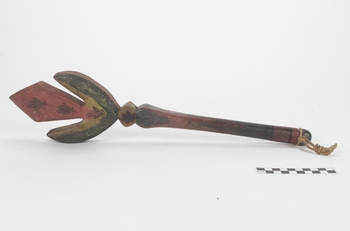 |
| “Dance wand used in the dance of San Roque” by the Zoque people of southern Mexico. (Nat’l Museum of the American Indian.) |
Pentagonal Mounds & Bearded Indians Another Olmec Indicator?
Additionally, near the previously mentioned Tama, Louisiana is a Native American mound site known as Emerald Mound. It was built around 1250 AD, the same time period that Spiro was abandoned and the Etowah site was repopulated. Emerald Mound covers over eight acres, is pentagonal in form and has several additional mounds constructed on top of it.[xl] It is very similar to the Stirling Acropolis at the Olmec site of La Venta in Veracruz, Mexico.[xli]
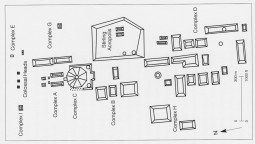 |
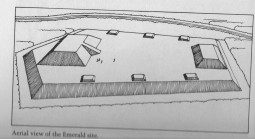 |
| Stirling Acropolis at La Venta with additional mounds built on top. (from The Olmecs) | Emerald Mound site plan showing its pentagonal form with additional mounds built on top (from |
It should be noted that the Olmecs are known for constructing earthen mounds although they had the technology to build stone pyramids. Likewise throughout Georgia and the rest of the southeast, the inhabitants built with earth not stone.
The largest mound at the Etowah Mounds site is also pentagonal in form and constructed from earth. It has been noted that during the historic era, a Creek tribe named the Ocute still built pentagonal mounds. Curiously, early Spanish eye-witness accounts of the Ocute noted their men wore mustaches and their priests wore long beards.
An Olmec cave painting in Guerrero near where the previously mentioned stela was discovered shows an Olmec priest who is also bearded.
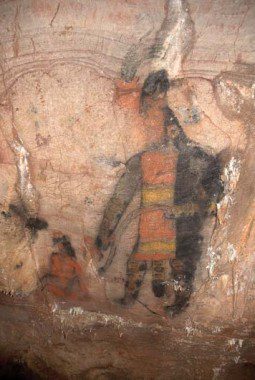 |
| Olmec cave painting in Guerrero[xlii] |
Bearded depictions of leaders are rare throughout the Americas yet the Olmec have several such depictions of their leaders across time and geographical regions. Thus to have eye-witness accounts of such bearded leaders in the same geographical region in America where other western Mexico cultural traits also appear provides one more layer of evidence, though circumstantial, to the case for a western Olmec tribe (possibly the Zoque) being one of the four who took part in the migration out of west Mexico.
What was the significance of the pentagonal form? One clue comes from an engraved pot design which shows a pentagon within a swirling wind design thus suggesting that the pentagonal form was associated with the Creek Indian’s Wind Clan, their most ancient clan.
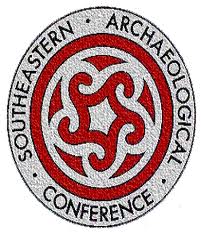 |
| Swirling wind/swastika design enclosing a pentagonal shape used as the logo for the Southeastern Archaeological Conference |
As noted previously, in Mesoamerica the god Ehecatl-Quetzalcoatl is also associated with the wind. He is also associated with Venus as well. Is their any evidence that the Mississippian swirling wind/swastika design was also associated with Venus?
In fact, there is. A shell gorget from Spiro Mounds shows a series of four feathered serpents in the form of a swastika surrounding a central cross-shaped symbol that throughout North and South America is associated with the planet Venus.
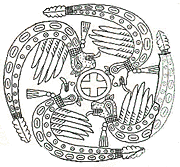 |
| Spiro Mounds shell gorget featuring a swirling wind/swastika design created from four feathered serpents surrounding a Venus cross |
Thus three ideas (feathered serpents, wind, & Venus) are linked together on this shell gorget in the exact same way as they are in Mesoamerican religion.
Also, cloth adorned with the Mesoamerican Venus symbol was found in a high status burial at Etowah suggesting that the chief, who lived atop the pentagonal Temple Mound, was associated not only with the sun but also Venus, the Morning Star.

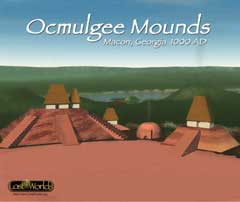
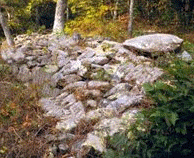
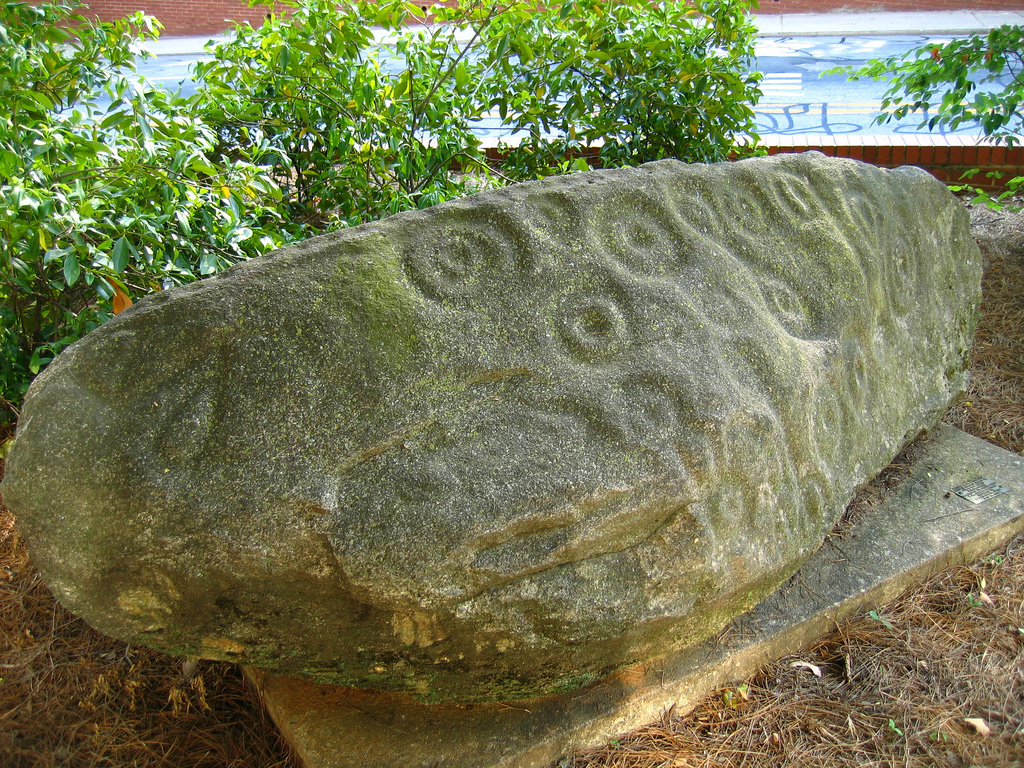
Very fascinating discourse! Results from my STR ancestry DNA calculator confirm the Mexico/southeast U.S. migration with the the Cora people of Nayarit being directly related to the Creek Indians of Georgia.